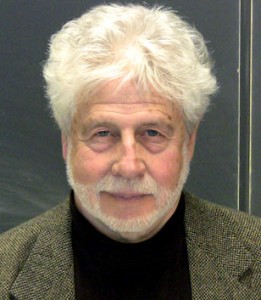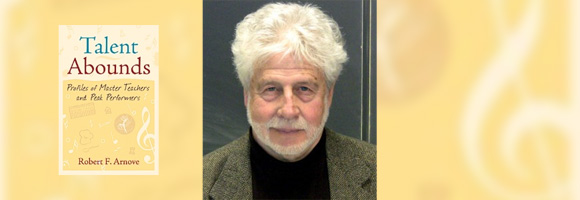 The book Talent Abounds: Profiles of Master Teachers and Peak Performers, from Paradigm Publishers written by Robert Arnove, Chancellor’s Professor Emeritus at Indiana University and a leading scholar of comparative and international education, suggests that great teachers who turn out great students across disciplines share some common traits. The book features interviews with some of the leading figures in various fields, from music to mathematics to culinary arts.
The book Talent Abounds: Profiles of Master Teachers and Peak Performers, from Paradigm Publishers written by Robert Arnove, Chancellor’s Professor Emeritus at Indiana University and a leading scholar of comparative and international education, suggests that great teachers who turn out great students across disciplines share some common traits. The book features interviews with some of the leading figures in various fields, from music to mathematics to culinary arts.
Arnove found that these master teachers, who had all made a mark as performers in their fields, wanted to make a greater impact by sharing their experiences and insights. ”It was going beyond existing knowledge to make their own unique contribution or signature,” Arnove said. “It was a desire on their part to teach and have their students participate in a community of practice extending back generations, and, at the same time, not have their students be clones. They would not impose, but they would guide.”
The idea for the book hatched 25 years ago, and Arnove began conducting interviews in 1994, beginning with violin master Joseph Gingold, the longtime IU Jacobs School of Music professor who began teaching at age 13 and mentored internationally-renowned students such as Joshua Bell. That same year, he interviewed kinesiology professor James “Doc” Counsilman, known as the oldest person to swim the English Channel but also as the coach of national champions at IU and gold medal winners, including Mark Spitz, who won seven at the 1972 Olympic Games.
Other master teachers profiled in the book include Sylvain Cappell, the New York University mathematician who developed an important theorem in the field of geometric topology. Among these teachers, Arnove said he found they had an “X-ray vision” for their students.
“They are able to diagnose where that individual is and then what set of stimuli or tasks are needed to raise the student to the next higher level of performance, or knowledge, or insight,” he said.
 As a result, these teachers would personalize the instruction for their students. All of the master teachers also had a curiosity that allowed them to develop new domain knowledge and improved ways of teaching. “Someone like Doc Counsilman studying physics and the Bernoulli principle,” Arnove said, referring to the coach’s application of the Swiss physicist’s work on fluid dynamics to swimming.
As a result, these teachers would personalize the instruction for their students. All of the master teachers also had a curiosity that allowed them to develop new domain knowledge and improved ways of teaching. “Someone like Doc Counsilman studying physics and the Bernoulli principle,” Arnove said, referring to the coach’s application of the Swiss physicist’s work on fluid dynamics to swimming.
Each of the teachers shared some common background, Arnove discovered. “One is an early start,” he said, noting that usually there is a strong family influence. “But also the encouragement of school teachers, education programs that were available and a series of interventions by increasingly more sophisticated master teachers who could raise some of these performers in the arts and athletics to world-class levels.”
To further expand the concept, Arnove also studied lesser-known, but recognized, excellent teachers. His research assistant Margaret Clements interviewed more than 30 Armstrong Teacher Educators, an elite group of Indiana teachers selected by IU School of Education faculty every year to serve as mentors for new teachers and gain professional development. School superintendents and principals nominate them based on patterns of outstanding teaching and school leadership.
“They all have the same characteristics of these world-class, famous, internationally prominent teachers,” Arnove said, which led him to conclude that the research has important implications for curriculum and policy.
“Schools of education need to provide students with a full panoply of concepts and ideas and skills taken from the arts as well as from history, philosophy, sociology, anthropology, comparative education and history,” he said. “Teachers need these ideas and principles so that they can approach teaching as an ethical endeavor, as an undertaking involving the care and development of individual students.”
In the public schools, Arnove said teachers also need access to resources and conditions to make them successful: “It’s not just what the exceptional teacher does with extraordinary students, but what your average classroom teacher can do with all students,” he said. “Teachers need that kind of support and autonomy to apply their knowledge.”
Arnove says the great teachers he found had a desire to nurture great talent: “…then going beyond to make their own unique contribution or signature, and then a desire on their part to teach and keep up this tradition and have their students not be clones. They would not impose, but they would guide.”
Research on Indiana teachers selected annually as outstanding teachers found parallels with the style of the well-known teachers, Arnove says: “We interviewed some 30 or more of the Armstrong teachers who have been identified by their school superintendents as super teachers, great teachers, and they have all the same characteristics of these world-class, famous, internationally prominent teachers in the music school or in other areas, which is again being able to personalize instruction, know where their students are, know what tasks to assign, having the constructive problem-solving with the students, not giving them solutions, but stimulating them and then providing the resources so these people can investigate problems or practice and other resources to dedicate themselves to what engages them.”
Arnove says support makes a difference for successful teachers: “The book is, you know, it covers a wide range of fields and countries and cultures, and it tries to find out what makes for a great teacher, and we find out that public school teachers share these same characteristics with these internationally prominent teachers in conservatories, in university music schools, or in very elite athletic programs. What they need is the resources and conditions to enable them to be effective. It’s not just what the exceptional teacher does with extraordinary students, but what your average classroom teacher can do with all students.”
—————————
Source for the original English edition: Amazon
Click here to watch this book presentation for the Spanish edition.



